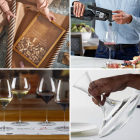It’s no secret that Germany is big on its beer and bratwurst, so few would automatically regard it as a major wine-producing country. But Germany’s wine industry is surprisingly vast and varied, and we’re not just talking about Riesling.
1. Germany has a long winemaking history
Germany has been making wine for almost two thousand years. In the Sachsen region – one of the more recent regions to receive official wine-producing status – records of winemaking go back to 1161. Historians say that Romans were cultivating vines in the Mosel as far back as 330 AD, while Saale-Unstrut, Europe’s northernmost wine-growing region, has been producing wine since 998 AD.
2. Germany is a top 10 wine-producing country
The latest figures from Statista place Germany ninth in the top 10 wine-producing countries of the world – just shy of South Africa and ahead of China. With an annual production of around nine million hectolitres it might trail behind wine powerhouses such as Italy and France, but it’s ahead of more commonly-cited winemaking countries such as Portugal, New Zealand and Hungary.
3. Germany doesn’t only produce Riesling
Riesling is to Germany as Malbec is to Argentina, but the country has a much wider grape variety than you might think. The Muller-Thurgau, the second most commonly planted grape in Germany, is a cross between Riesling and Madeleine Royale. This type of grape is used to make wine with a light, aromatic and floral taste. The third most planted grape is the Spätburgunder, also known as the Pinot Noir. This type of grape produces wine that emphasises purity and precision of the fruity flavour through the use of oak barrels. Then you’ve got your Gewurtztraminers, Schwartzrieslings, Weissburgunders and more, including more well-known grapes such as Sauvignon Blanc.
4. And its Rieslings aren’t always sweet
Riesling might be synonymous with sweetness, but in Germany Riesling comes in pretty much whatever form you want. For a very dry Riesling look for ‘trocken’ on the label – this signifies a dryer wine with fewer than nine grams of residual sugar per litre. ‘Halbtrocken’, meanwhile, is considered semi-dry and has no more than 18 grams of sugar per litre. Many labels will bear the words ‘kabinett’, ‘spätlese’, ‘auslese’, ‘beerenauslese’, ‘trockenbeerenauslese’, or ‘eiswein’ on the label. This denotes the ripeness of the grapes when picked, with kabinett being the least ripe, followed by spätlese and so on. The longer the grapes stay on the vine, the more sugar they will develop.
5. Germany is the world’s third largest producer of Pinot Noir
While Riesling will almost certainly spring to mind when you consider German wine, the grape – and indeed the country’s white wines overall – are really only part of the picture. After France and the US, Germany is the world’s third-biggest producer of Pinot Noir, known as Spätburgunder. In fact, it accounts for more than 60% of the grape plantings in the rocky hillsides of the Ahr region, known as Germany’s ‘red wine paradise’. If you prefer your reds on the lighter side try Trollinger, which boasts slightly smoky strawberry flavours, while velvety Dornfelder from the Pfalz or the Rheinhessen is a good choice if you’re looking for a red with a bit more weight to it.
6. Germany’s wine have great ageing potential
Many German winemakers have a deep affinity for oak barrels, which means their vintages – even their whites – will maintain depth and quality long into the future. Quality Riesling in particular has the ability to age well. Over time, the fruit recedes and yields to aromas and flavours of beeswax, butter, smoke, pine, honey, butterscotch, mushroom, and citrus preserve. Any residual sweetness also bonds with the acidity resulting in a more cohesive textural component and drier expression of the wine. In 2008, the first Riesling Fellowship saw Rieslings dating back to 1900 tasted by a panel of experts, all to great acclaim.
7. Germany’s vineyards are steep
Many of Germany’s vineyards are worked completely by hand, and not because of tradition, but because they’re terraced into hills so steep that machinery can’t reach them. The Mosel-Saar-Ruwer region, for example, is famous for having the steepest vineyard in the world, with a 60% gradient and a height of 951 feet.
8. Germany has a ‘Wine Queen’
Every year the German Wine Institute chooses a German Wine Queen from one of the country’s 13 wine-producing regions. The queen – chosen by a 70-member jury of industry professionals and press – must show a strong dedication to German wine, and will spend her year-long reign communicating the world of German wine to the global public. The current and 72nd German Wine Queen is 22-year-old Eva Lanzerath, from the Ahr region.






